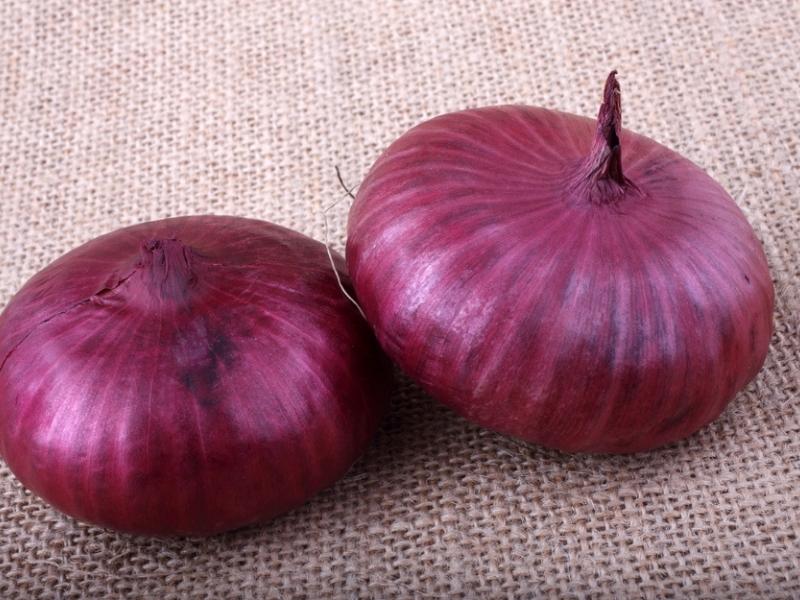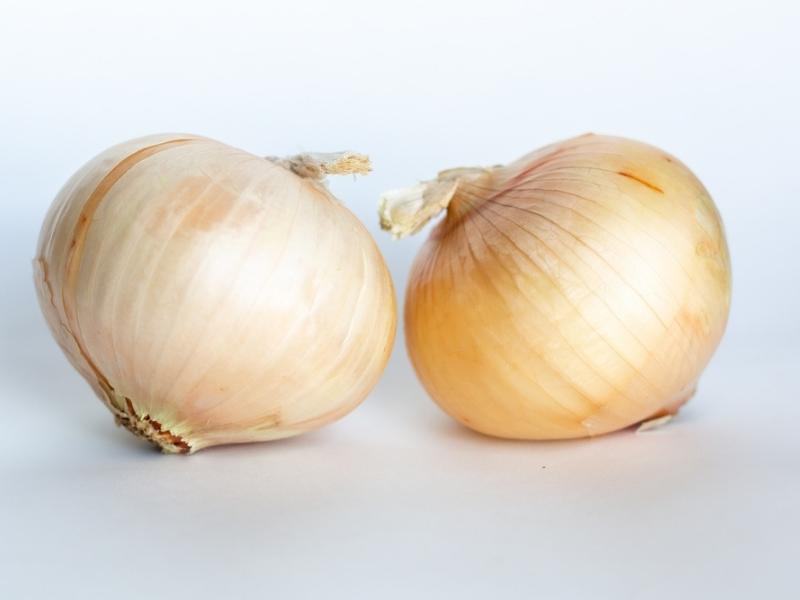From bright and peppery to sweet and fragrant, there are so many unique types of onions.
And whether you like them on your burgers, in your salads, or caramelized over a thick, juicy steak, it’s important to know which onion to choose.
So check out this list to get to low down on this humble pantry staple.

Let’s all take a moment to praise the mighty onion. They can make or break a dish, after all.
And did you know there are seven different types of onions, with various other types within each category?
It can get a little confusing, which is what this post is all about!
I’ll cover 20 types of onions and how to use them, so your next onion dish will be the best of the best!
20 Types of Onion
As mentioned, there are seven different types of onion. They are:
- Green onion
- Leeks
- Yellow onion
- Shallots
- White onion
- Red onion
- Sweet onion
Within those seven categories are different styles of onion.
Some are so intense, you’ll need to break out your onion goggles, while others are mild enough to eat like an apple.
So, knowing which type of onion works best in a dish is your key to success.
For instance, if you’re carmelizing onions, you want a sweet onion with a high sugar content. Vidalia onions or Walla Walla are terrific for caramelizing.
Of course, sweet onions caramelize like a dream, but if you try to caramelize a potent onion, like a yellow one, it will be bitter and bland.
If you’re unsure which type of onion to use in a recipe, check out this quick guide that breaks down 20 different styles of onions and where they work best.
1. Red Onion

Red onions are known for their lush red-purple and white-marbled skin.
They have a peppery, almost spicy flavor when they’re at their peak. Though they can be a touch sweet sometimes.
And when they’re at their peak, you’ll probably need to bust out your onion goggles when chopping them.
When raw, the peppery flavor and wonderfully crunchy texture make them ideal for use in salads and other dishes.
I really enjoy them grilled on burgers too. Cut them nice and thick and leave to char on the grill for a few minutes on either side.
2. Sweet Onions

Sweet onions, like Walla Walla and Vidalia, are mild and – you guessed it! – sweet.
Because of this, they’re lovely raw in salads and dishes that need a slight hint of alliums without overpowering.
If a recipe calls for caramelized onions, sweet onions are your best choice. The sugar content makes sure they’re sticky and golden brown.
Sweet onions are also perfect for fajitas and Philly cheese steaks. Oh, and they make the best onion rings!
3. Shallots

Shallots are a cross between an onion and garlic. So they’re slightly sharp with sweet, garlicky notes.
They’re smaller than your average onion but just as potent. That means you’ll probably tear up when chopping them.
Because they aren’t as sharp as other onion varieties, they’re great for roasting alongside other veggies or pureed into a salad dressing.
4. Yellow Onions

When in doubt, you can’t beat yellow onions. They’re the workhorse of the kitchen thanks to their sharp onion flavors and tough skin.
Be warned: yellow onions are high in sulfuric acid and can irritate your eyes. When people cry when chopping onions, yellow onions are likely the culprit!
But that intense flavor makes them perfect for hearty soups, stews, and chilis, where other bold flavors would overpower, say, shallots.
5. White Onions

White onions fall between yellow and sweet onions on the grand onion scale.
They have a sharp flavor without added sweetness but aren’t as intense as yellow onions.
You can use them in soups or stews and eat them raw (in smaller quantities) in guacamole or macaroni salad.
6. Pearl Onions

Also known as ‘baby buttons,’ pearl onions are small, delicate, and offer quite a bit of sweetness.
When roasted, the flavors are quite savory and go great with a host of other veggies.
That said, they’re generally relatively mild, so they’re often used in glazes, as a side on their own, and even in cocktails.
Unfortunately, pearl onions are tedious to peel, so set a little extra time aside.
7. Spanish Onions

Spanish onions live in the yellow onion family. In fact, they usually appear in supermarkets labeled as yellow onions because their flavors are similar.
Unlike the standard yellow onion, Spanish onions are slightly sweeter and can even be used raw as a burger topping or tossed in a salad.

8. Scallions (Green Onion)
Scallions are an allium, which is an umbrella term for onions and garlic.
Also known as ‘green onions,’ their leaves are often valued more than their bulbs.
They have a distinct onion-like flavor that’s bright and peppery, making them terrific in salads and as garnish when raw.
9. Cipolline (a.k.a. Cipollini)

As you’ve probably guessed from the picture, cipollini onions are a member of the sweet onion family.
In Italian, the name translates to ‘little onion.’ And their high sugar content makes them ideal for onion rings or caramelized onions.
Another excellent option is to peel and roast the whole with butter and aromatics.
Serve them on the side of chicken or steak for a sweet and savory kick.
10. Chives

Chives are always great if you want to add an oniony pop to your dish. They’re part herb, part onion, and 100% delicious.
The delicate green leaves are mild and are more similar to a leek than a yellow onion.
They have myriad uses, from a garnish to a salad ingredient to an omelet flavor enhancer.
11. Leeks

Leeks look like green onions that hit the gym.
Their sweet onion flavor is an excellent addition to meaty dishes or pasta recipes.
They aren’t as pungent as yellow onions and add an incredible depth of flavor that’s oniony and garlicky.
The bulbs offer intense onion flavors, but the leafy greens are great for vegetable stock.
When prepping leeks, you’ll want to chop and soak them in cold water before use. Dirt and bugs can get stuck between the leaves, which nobody wants to eat!
12. Maui Onions

Maui onions are so sweet, you can eat them raw.
However, they shine when caramelized. So if you want to make the best caramelized onions ever, it doesn’t get much sweeter than the Maui onion!
They’re great for recipes that call for sautéd onions, too.
I like to use them for onion rings because the sweet flavor really pops against the crispy coating.
13. Walla Walla Onions

Walla Walla onions are another member of the sweet onion family.
While many sweet onions earn their sweet flavors from sugar, Walla Walla onions are slightly different.
They are sweet, but only because they have very low sulfur content. (Which means your eyes won’t water when chopping them!)
14. Bermuda Onions

Bermuda onions are large and in charge. But don’t let their giant stature fool you into thinking they’re potent.
Overall, Bermuda onions offer similar flavors to Vidalia but are actually milder.
They have a flavor profile similar to shallots and work wonderfully in both cooked and raw dishes.
15. Cocktail Onions

Cocktail onions aren’t actually a type of onion. Instead, they’re a way of preparing onions – usually pearl onions.
They’re pickled in brine, typically with turmeric and paprika. And the sweet-tangy flavor makes them perfect for salads and drinks.
I use them on charcuterie boards, where the salty meats and cheeses need a bit of zippy balance.
16. Egyptian Onions

Egyptian onions taste like shallots but offer more peppery and spicy notes. When eaten raw, they more or less tastes like a spicy onion.
Their complex flavor profile is a great way to add a punch of flavors to soups or stews but mild enough to use raw on a juicy burger.
17. Boiling Onions

Boiling onions may have a mild flavor compared to yellow, but they’re still a little too intense to eat raw.
That said, with their low water content, they’re the perfect addition to lighter soups and stews that need a milder onion kick.
18. Torpedo Onion

The torpedo onion earns its name from the torpedo-like shape of the bulbs. And it’s basically Italy’s take on the red onion.
It has similar mild and sweet flavors to traditional red onions. So it’s ideal for raw dishes like pasta salads. But it’s tough enough to roast or grill, too.
19. Welsh Onion

While a Welsh onion looks very similar to a green onion or leek, there are subtle differences in flavor.
And despite its name, this onion is native to Asia. In fact, it was referenced in Chinese literature as early as 100 BC!
When cooking Asian cuisine at home, like stir-fries or hot pots, the Welsh Onion adds a subtle sweetness with onion flavors that aren’t overpowering.
20. Vidalia Onion

Yes, I’m saving the best for last!
The Vidalia onion is sweet, mild, and incredibly tasty. This hearty onion is a staple of American cooking and can is used in almost anything.
The flavors are so mild that they make a great burger topping or salad addition and work well in cooked dishes.
Plus, thanks to the high sugar content, these caramelize like a dream and can also be grilled or roasted.
When in doubt, Vidalia is always a great choice!











